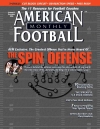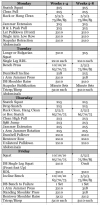AMERICAN FOOTBALL MONTHLY THE #1 RESOURCE FOR FOOTBALL COACHES
Article CategoriesAFM Magazine
|
The Strength Report: Running Backs and Wide Receiversby: John ArcherStrength Coach University of Nevada © More from this issue As a strength and conditioning coach at the Division I-A level, philosophically, I feel you have to first develop core beliefs, which guide you in creating your specific training methods. These core beliefs must first and foremost be grounded in scientifically proven methods, which speak to the specific athletic goals of the athletes and sports you are focused on. The primary philosophy I follow in program design for football is a system utilizing individual phases solely geared toward developing muscular mass, strength, and explosive power. Even so, when training athletes of any kind it is important to note that we as strength coaches must focus on training movements and not just individual muscle groups in order to improve an athlete’s athletic performance. At Nevada, our programs for football utilize three core lifts of Hang Clean, Squat, and Bench Press, as well as several variations of these depending on what phase of the year we are in and the specific needs of the individual athlete and their position. While these programs are position specific, they must also be tailored to meet the individual needs of each athlete in order to address their strengths and weaknesses relating to strength, power, and the overall efficiency of movement and mobility. Specifically speaking to the needs of Running Backs and Wide Receivers, many adaptations to the core lifts of the Hang Clean and Squat are utilized in order to develop and maintain speed, agility, and more importantly, mobility in the hips given the athlete’s need to move and accelerate effectively in space. The use of Lunges, variations of Single Leg Squat, Single Leg RDL, light rudimentary versions of the Olympic Lifts, and 3 dimensional explosive movements that focus on the triple extension of the hips, knees, and ankles all aid in achieving these goals. However, there are certain genetic predispositions in the majority of “speed athletes” like Running Backs and Receivers that can lead to decreased performance and injury. For example, one common issue occurs when the athlete is overly lordodic (overly arched back). In these instances, the athlete has an increased chance for hamstring pulls and will surely see considerable tightness in the hip flexors. Therefore, while loading the legs during the squat is necessary to gain mass and strength, the amount of weight lifted is not the primary focus for these athletes. Instead, much consideration is given to keeping the athlete’s hips in a more neutral position by not overstretching the hamstrings, stretching the hip flexors, and utilizing functional hip mobility warm ups. Focusing on the proper function of the hips will allow these athletes to make the necessary gains in the weight room without limiting the gains in speed, agility, and mobility.  Strenght Chart - Click to Enlarge In-Season vs. Off-Season Throughout the year, there are few times when a college football player is not lifting or training in some fashion. At Nevada, our players predominantly lift four days a week during each phase with the exception of the period during spring practices. However, during each one of these phases, the predominant goals of the program differ to some extent. The phases of major focus are In-Season, Winter Conditioning, and Summer Conditioning. During the in-season, while our players still lift four days a week, the amount of weight an athlete uses is on average about 10-15% lower for all lifts while the volume of repetitions is varied in order to assure the athlete will maintain strength and body mass throughout the season. During the in-season phase, the Running Backs and Wide Receivers lifting program is set up with each of the four days having a distinct purpose. Monday and Tuesday are utilized as their moderate or “In-season Heavy” strength and explosive days, respectively. For example, on Monday they will Bench Press using a pyramid rep scheme in order to help them maintain mass as well as strength, Squat for sets of 5 repetitions, and perform some accessory strength lifts. All the above are done with assigned weight which, for this time of the year pushes them, yet meets the overall goals of maintenance and doesn’t detract from the athlete accomplishing what is expected of them on the practice field. Tuesday, I have them performing Hang Clean and two explosive 3 dimensional exercises with “In-season Heavy” weight and two accessory back exercises such as Lat Pulldown and Low Row. Wednesday and Thursday are what I call “unloading days.” For the Running Backs and Receivers, Wednesday they would now do only two base strength movements with much lighter weight and move the weight explosively through the range of motion and Thursday would be much the same but again with Hang Clean and two accessory explosive movements. Using this methodology, we can push them to some extent early on Monday when practice is lighter as far as contact and speed, then unload them late in the week when practice is much more intense and the main focus needs to be recovery for the game on Saturday. In a sense, my goal is to utilize movements in the weight room, along with the phasing of practice during the week to somewhat peak them to feel their best physically by game day. During the off-season phases of winter and summer conditioning, our backs and receivers again lift four days per week (See Off-season Workout Schedule). However, due to the greatly increased intensity during these periods, the days of lifting are now Monday, Tuesday, Thursday, Friday with Wednesday being utilized as an off day to assure proper rest and recovery. Within each week, two days per week (Monday and Thursday) are noted as a heavy and light explosive days, respectively while Tuesday and Friday are the days focused on mass/strength development. Even though there are similarities in the two phases of winter and summer, our primary goals for the Running Backs and Receivers differ during each period. For football players in general, winter tends to be the time when our focus leans greatly toward making the greatest gains in mass and strength. For our Running Backs and Receivers this is still predominantly the case. However, given the fact that many athletes in these positions don’t need the mass weight gains that you desire in linemen, the focus is toward greater strength gains, functional strength, and of course, speed. As I stated before, I feel it is important during these phases to temper the mass gains of these particular athletes if it is going to promote the dysfunctions in the hip that may exist in different individuals. During the summer, the goals remain much the same for the backs and receivers for most of the phase. However, by mid-summer, it is imperative that the majority of the strength gains have been made so that speed, agility, and conditioning can take precedence. Trends in Strength and Conditioning We as strength coaches are more understanding of the fact now that just because some program is doing this program or that program and having great success, doesn’t mean that it will work for you and your athletes. Along with these changes, there have been tremendous advances in strength training equipment that benefit us on a daily basis. The research itself is much improved with major advances in the functional movements new machines will perform. There has also been a great increase of companies who develop machines that can be used to perform a multitude of exercises, which makes these machines also more cost effective. For example, the Ground Base Jammer from Hammer Strength is used four days a week in our facility and in a different manner each day. The multi-functional qualities of these pieces of equipment have aided us in our effectiveness, while immediately increasing the amount of useful space within our facilities. Another trend in the field of strength and conditioning is the increasing trust and value that doctors and trainers are placing on strength coaches by utilizing us as an integral part of what I would call a rehabilitative unit. At Nevada in particular, we have worked together with our Medical and Training Staffs and created unified protocols in rehab and reconditioning programs that have shown to decrease the amount of time our athletes miss from practice as well as games. Further, many of the athlete’s whose injuries required surgery, have actually returned to their respective arena stronger and more functionally sound than before. |
|
| HOME |
MAGAZINE |
SUBSCRIBE | ONLINE COLUMNISTS | COACHING VIDEOS |
Copyright 2025, AmericanFootballMonthly.com
All Rights Reserved




